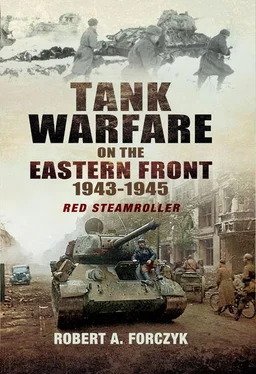Generalleutnant Arno Jahr committed suicide on 20 January 1943 when his unit was surrounded and General der Infanterie Karl Eibl was killed in action during the retreat on 21 January.
In January 1943, the Ostheer reported a total of 82,110 casualties, of which 17,183 occurred in Heeresgruppe Mitte (21 per cent of the total) and 29,023 occurred in Heeresgruppe Nord (35 per cent of the total). While some of AOK 6’s casualties at Stalingrad were not reported until February, the fact that Heeresgruppe Nord and Mitte together suffered over 12,000 dead or missing in January 1943 indicates the ferocity of combat occurring elsewhere on the Eastern Front.
General der Infanterie Kurt von Chevallerie, commander of the LIX Armeekorps, was in charge of the overall relief effort. The 20.Infanterie-Division (mot) was also attached to this operation, but had no tanks.
Heeresgruppe Don was redesignated as Heeresgruppe Süd on 13 February 1943 when Heeresgruppe B was dissolved. However, Heeresgruppe A remained as a separate command in the Kuban.
On 12 February Generalleutnant Erhard Raus took command of this formation and it was renamed Generalkommando z.b.V. Raus.
This formation had been established in July 1942 as SS-Panzer-Generalkommando and during the Third Battle of Kharkov in February-March 1943 it was known as the ‘SS-Panzerkorps’. In June 1943 it was redesignated as the II. SS-Panzerkorps and retained this designation for the rest of the war.
The 4th Tank Corps was redesignated as 5th Guards Tank Corps (5GTC) on 7 February 1943.
Remer would later gain considerable notoriety for crushing the July 20th Plot against Hitler.
Herzig was not relieved of command for this lapse in judgment, but was quietly shifted to another assignment after a month. From January–May 1945 he commanded the King Tigers of the s.SS-PanzerAbt.503 in the final battles.
In June 1943 Hausser’s SS-Panzerkorps was redesignated as II./SS-Panzerkorps.
Panzer-Abteilung 51 was formed from the II./Pz. Regt. 33 (9.Panzer-Division) and Panzer-Abteilung 52 was formed from the I./Pz, Regt. 15 (11.Panzer-Division).
On 1 May 1943 the SS-Panzerkorps sent two of its six Panzer-Abteilungen (I./SS-Pz. Rgt. 1 from LSSAH and I./SS-Pz.Rgt. 2 from Das Reich back to Germany for conversion to Panthers.
Vatutin took command of the Voronezh Front on 28 March after Golikov was relieved by Stalin.
Funklenk or Fkl were radio-controlled demolition vehicles. A team usually consisted of a Pz III control tank and several associated BIVs. The vehicles were driven into the edge of a minefield by a human driver and then detonated by radio command, intending to detonate nearby mines with blast over-pressure. The Germans estimated that at least four BIVs were needed to clear a 100-metre deep lane through a minefield and that this would take two hours to complete. However, a critical flaw was that the Panzerkompanie (Fkl) had no means of marking cleared lanes.
Kessel was an odd choice to command a Panzer-Division in such a key battle since he had been head of the Heer’s Personnel Department in 1939–42 and had no recent command experience. Nevertheless, he went on to command a Panzerkorps by late 1944.
TUNNY, a sub-set of ULTRA, was involved in intercepting copies of German operational orders. Both the April warning order for Zitadelle and the actual operational plan were passed on to the Soviets by the Soviet spy in Bletchley Park, John Cairncross.
Decker and his brigade headquarters did not arrive until 11 July, by which point there were very few Panthers left to command.
The engine fires were caused by excessive heat, caused by a rubber liner installed in the engine compartment intended to keep the compartment dry in river-crossings. However, the rubber lining also retained engine heat and resulted in the destruction of a number of Panthers.
Saurma was Strachwitz’s brother-in-law. He was wounded by bomb fragments and later died of his injuries.
Kotenko survived the war and later recommended one of his battery commanders, who fought to the death, for the Hero of the Soviet Union (HSU) award.
Lebedev was a very experienced tanker who had fought in the Russo-Finnish War in 1940, the Luga River line in 1941, around Voronezh in 1942 and in the Ostrogozhsk– Rossosh Offensive in early 1943. He was part of the new breed of veteran Soviet tankers that would lead the drive to the west in 1943–45.
Tebbe had previously commander Panzer-Abteilung 116 in 1942–43. Despite being replaced for his failure of leadership during Zitadelle , Tebbe would command another Panther-Abteilung, I./Pz. Regt. 16, during the Battle of the Bulge in 1944.
It is not uncommon inside a cramped tank turret to be in the wrong place at the wrong time, particularly when fatigued and stressed. Accidental injuries inside tank turrets are not uncommon and usually very serious. Strachwitz apparently suffered a crushed arm and shoulder.
Both George Nipe and Valeriy Zamulin claim that Hoth was aware of 5 GTA’s approach or at least that the Soviets were planning a major counterstroke. Perhaps, but the Lage Ost situation maps for 11 July 1943 do not indicate it and the general alarm noted in German accounts of Prokhorovka suggest genuine surprise that the Soviets were mounting such a large-scale armoured attack.
Franz Bäke (1898–1978) was a pre-war dentist and reserve officer, who rose very rapidly in the Panzertruppe. He served as a tank platoon leader in Pz 35s in Poland, a company commander in France in 1940, then a battalion commander in 1942. He led II./Pz.Rgt. 11 in Wintergewitter , the Third Battle of Kharkov and Zitadelle in 1942–43. In November 1943, he was promoted to Oberstleutnant d. R. and given command of Panzer-Regiment 11.
Carell, aka SS-Obersturmbannführer Paul Karl Schmidt, was the press spokesman for the Third Reich’s Foreign Ministry and the creator of the highly-successful Signal magazine. He was a major component of the Third Reich’s propaganda machine but was not indicted after the war and reinvented himself as ‘Paul Carell.’ His books are interesting and well-written, but also convey the German wartime propaganda line that the Soviets only won due to superior numbers.
Interestingly, after the fall of the Soviet Union Koltunov admitted that he had exaggerated German losses and had been part of an official white-washing about Soviet losses at Kursk.
The Pak41 was Germany’s best towed anti-tank gun, introduced in April 1942, but only 150 were built. It used the tapered-bore principle to produce an exceptional muzzle velocity of 1,125 m/second. Using Hartkern rounds, the Pak 41 could defeat the KV-1’s thick frontal armour out to 2,000 metres.
Sky-lining is a common tactical mistake made by inexperienced (or incautious) tankers, which entails moving with the vehicles’ outline clearly visible on high ground with a rising or setting sun behind it. Normally, tanks traverse high ground along the ‘military crest of the hill’ (i.e. 10 metres below the actual crest) in order to avoid this dangerous mistake.
Читать дальше








![John Stieber - Against the Odds - Survival on the Russian Front 1944-1945 [2nd Edition]](/books/405234/john-stieber-against-the-odds-survival-on-the-russian-front-1944-1945-2nd-edition-thumb.webp)



